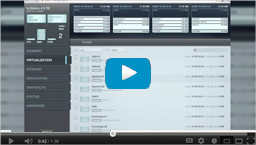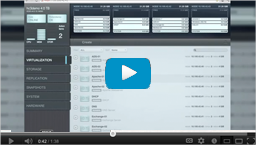Scale Computing Technology
Scale Computing’s HC3 and the ICOS architecture were designed to provide highly available, scalable compute and storage services while maintaining operational simplicity through highly intelligent software automation. ICOS puts intelligence and automation in the software layer and was designed to take advantage of low cost, easily replaceable and upgradable “commodity” hardware components including the virtualization capabilities built into modern CPU architectures. These attributes combine to create a flexible and complete “datacenter in a box,” with additional nodes being automatically “incorporated” into the cluster and failed hardware being expected, and easily replaced with minimal effort or disruption.
HC3 and ICOS v4 are based on a 64-bit hardened and proven OS kernel – and leverage a mixture of proprietary and adapted open source components.
Cluster Formation
Once Scale Cluster nodes are racked, cabled and configured with physical network connectivity, the cluster formation process takes multiple nodes (currently 3, 4, 6 or 8) and logically bonds them together to act as a single coordinated system. Once a cluster is formed, it can be managed as a single system and all resources attached to each node are aggregated into a single managed pool of storage and compute resources.
While each node has its own physical network identity and interfaces, the ability to move and place virtual machines on specific nodes plus the use of Virtual IP Addresses that are managed and migrated between nodes by the ICOS software, lets the HC3 intelligently balance compute and I/O load among nodes and network interfaces in the cluster, maximizing overall system performance.
Virtual Machine Creation

Creating a virtual machine is a simple process that is accomplished through the Scale Computing HC3 Manager web browser user interface. The added Virtualization tab allows the user to specify required and optional parameters for the virtual machine including:
- Number of virtual CPU cores
- RAM
- Number and size of virtual disks to create; and to
- Attach a virtual DVD/CD ISO image for installing an operating system.
Cluster Expansion

After the initial node expansion to a three node starter system, ICOS was designed to allow additional node pairs to be added to the cluster at any time. Joining a new node pair to the cluster automatically adds its storage to the storage pool increasing storage and compute capacity and I/O handing. For storage protocols, a new virtual IP address is created allowing the node to begin participating in storage protocol load balancing. If the nodes are capable of running virtual machines, they are added to the HC3 pool and available for new VMs or for existing VMs to be live migrated to distribute load. New node pairs can be of the same or different type or capacity as the existing nodes in the cluster, but must match each other. When adding nodes with storage resources to an existing cluster, ICOS does provide the capability to re-balance existing storage to utilize all the new resources of the cluster. This process will essentially move some blocks from the older nodes onto the newer nodes to achieve an equal distribution of data across cluster nodes and drives. Consult with Scale Computing technical support to determine if this is recommended based on the current utilization of the cluster. For HC3 Virtual Machines, it is simple to immediately “move” running virtual machines to the new node to take advantage of the new compute resources.


